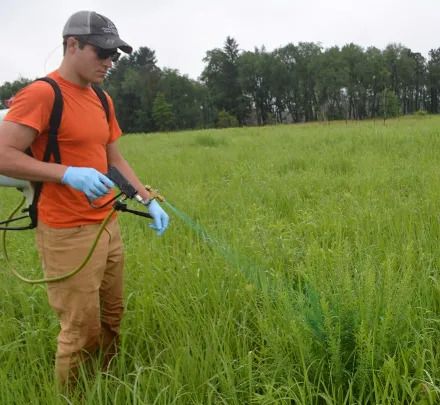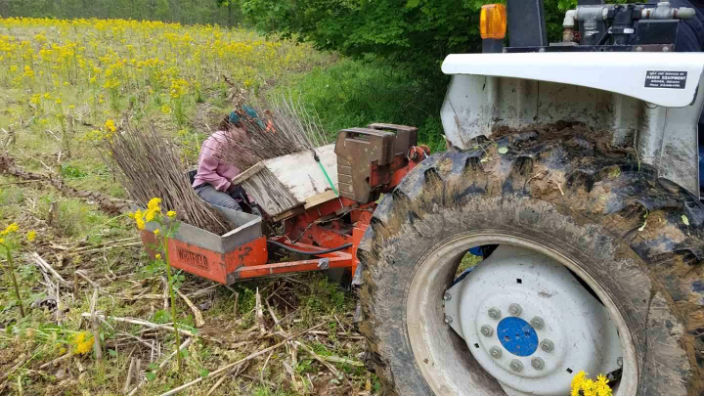


Timber Harvest
Planning, marketing, and managing commercial timber harvests to generate income for landowners and to help improve tree vigor, health, and productivity of residual trees and allow for shade-intolerant species to receive partial or full sunlight. The majority of timber sales that we administer are done on a sealed bid basis to encourage competitive bidding on the client’s trees. This helps to ensure that the landowner is getting the best price for their timber and they know what trees are being marketed.
The landowner has the right to accept and reject any and all bids so if the bids do not come in at a value that the landowner is happy with then they can walk away from the sale and not have any of their trees cut or removed. Whereas if a bid is accepted the seller (landowner) will enter into a contract with the purchaser (logger, timber buyer, etc) that will lay out the parameters of the harvest such as when logging operations may occur, expectations for the integrity of the soil before and after, fences removed or destroyed in the process, residual trees, and payment timeline. The seller will be given a down payment after the bid has been accepted and the full balance will be paid by a certain date or before any of the trees are cut, whichever comes first. The forester will administer the sale and visit the logging operation as needed to ensure the purchaser complies with the contract.
"Studies have shown that private forest landowners who sell timber with the help of a professional forester receive more money for their timber, cut fewer trees, have more residual volume and economic value left in the forest, and are more satisfied with the whole experience.” – Hank Stelzer
The landowner has the right to accept and reject any and all bids so if the bids do not come in at a value that the landowner is happy with then they can walk away from the sale and not have any of their trees cut or removed. Whereas if a bid is accepted the seller (landowner) will enter into a contract with the purchaser (logger, timber buyer, etc) that will lay out the parameters of the harvest such as when logging operations may occur, expectations for the integrity of the soil before and after, fences removed or destroyed in the process, residual trees, and payment timeline. The seller will be given a down payment after the bid has been accepted and the full balance will be paid by a certain date or before any of the trees are cut, whichever comes first. The forester will administer the sale and visit the logging operation as needed to ensure the purchaser complies with the contract.
"Studies have shown that private forest landowners who sell timber with the help of a professional forester receive more money for their timber, cut fewer trees, have more residual volume and economic value left in the forest, and are more satisfied with the whole experience.” – Hank Stelzer

Invasive Species Management
Management of nonnative, invasive woody, and herbaceous plant species. Invasive species limit land use, degrade natural resources, and inhibit recreational pursuits such as hunting, fishing, bird watching, and foraging. We will use different mechanical and chemical applications to manage invasive species that are present on your property.

Timber Stand Improvement (TSI)
Forest management practices improve the vigor, stocking, composition, productivity, and quality of forest stands. Examples include crop tree release, basal area thinning, site preparation for natural regeneration (understory removal), weed tree removal, and any other mechanical thinning operation.
- Managing Your Woods for White-Tailed Deer
- Fertilizing Oaks for More and Sweeter Acorns: Fact or Fiction?
- Forest Stand Improvement
- About Timber Stand Improvement (TSI)
- Managing Oaks for Acorn Production
- Wild Turkey Biology and Habitat Management in Missouri
- Oak Shelterwood
- Oak Shelterwood: A Technique to Improve Oak Regeneration
- Iowa's Forests
- Iowa's Forest Birds
- Oak Wilt: Identification and Management

Prescribed Burning
Utilizing prescribed fire to remove leaf litter and enhance nutrient-rich mineral seed beds to allow acorns to germinate and grow with less competitive stress. The fire will top kill smaller woody stems that will then stump sprout and serve as a food source for deer and cover for multiple different wildlife species.

Tree Planting
Planting bareroot seedlings to develop forest structure and species composition to provide wildlife habitat, clean and abundant water, forest wood products, recreation opportunities, soil stabilization, and many other benefits.

Timber Appraisals & Plans
Developing forest management plans for new landowners and completing timber appraisals to give an estimated value of standing timber to determine a basis to help with tax deductions after a commercial timber harvest. Forest inventory can also be performed as well.

GET YOUR FREE ESTIMATE TODAY!
Contact us to get started.

